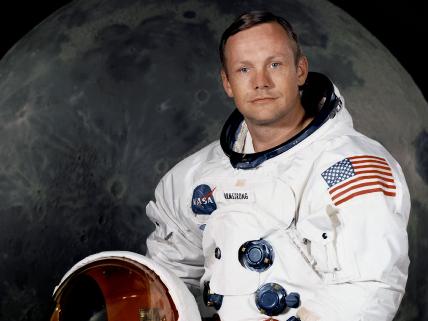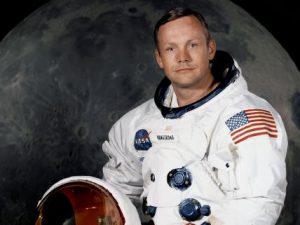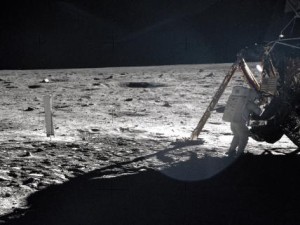

Neil Armstrong’s official NASA photograph taken in preparation for his Apollo 11 mission (Credits: NASA).
Neil Armstrong, most famous as the Apollo 11 astronaut who took man’s first step on the Moon, died on August 25 of cardiovascular complications two weeks after undergoing cardiac bypass surgery. Armstrong is survived by his wife Carol, four children and step-children, 10 grandchildren, a brother and a sister. He was 82 years old.
“Neil Armstrong was a hero not just of his time, but of all time,” said US President Barack Obama in response to the news. The event came as a surprise, since Armstrong had been reported as doing well following his surgery.
Armstrong was born on a farm in Ohio on August 5, 1930. He rode his first airplane at age six, from which point he developed a lifelong fascination with flight. He received his pilot’s license at age 16, before he even had a drivers license.
Amrstong joined the US Navy in 1949, flying 78 combat missions in Korea. After acquiring his masters degree in aerospace engineering, Armstrong went on to become a test pilot for NASA’s predecessor, the US National Advisory Committee for Aeronautics. He flew more than 200 aircraft models there before being selected as an astronaut in 1962.
Armstrong took his first spaceflight as commander of Gemini 8. There he performed the first docking in space before the spacecraft developed a rapid rolling motion due to a shorted thruster. Armstrong, known in piloting circles for his steely nerves, stabilized the craft using the reentry thrusters and safely brought it to an emergency landing.
Of course, Armstrong’s most famous flight was aboard Apollo 11. Lifting off on July 16, 1969, Armstrong and his fellow astronauts Buzz Aldrin and Michael Collins headed off for the most famous space mission of all time. As Collins remained in orbit, Armstrong and Aldrin descended in the Eagle Lander, then took man’s very first steps on the lunar surface. With 600 million people from around the world watching on live broadcast television, Armstrong uttered the now famous words “That’s one small step for man, one giant leap for mankind.”
Although all three astronauts returned to instant and enduring fame, Armstrong continually shunned the spotlight. A very private person, he was chary in granting public appearances and rarely spoke of his accomplishment. As he said in a rare 2012 interview “It was special and memorable but it was only instantaneous because there was work to do.” Neither was he one to rest on his laurels. Armstrong went on to serve as NASA’s deputy associate administrator for aeronautics at the Office of Advanced Research. He resigned from NASA in 1971 to pursue a research and teaching career at the University of Cincinnati where he remained until 1979. During that time, he went back to farming, purchasing 310 acres of land where he raised corn and cattle. He served as a member of the National Commission on Space in 1985 and 1986, and in 1985 was vice chairman of the Presidential Commission on the Space Shuttle Challenger Accident. He also was chairman of the Presidential Advisory Committee for the Peace Corps from 1971 to 1973. He later went into business, serving as chairman of Computing Technologies for Aviation Inc then of AIL Systems Inc, an electronic systems company.
In his few public appearances, several of which took place in the form of Congressional testimony, Armstrong discouraged people from hero-worship of his Moon landing feat. He saw a need to look forward rather than back to past accomplishments. He criticized the Obama administration’s space policy that backed off from a long-awaited return to the Moon, calling it “a misguided proposal that forces NASA out of human space operations for the foreseeable future.”
From beginning to end, Armstrong was the quintessential engineer. “I am, and ever will be, a white socks, pocket protector, nerdy engineer,” he said in a February 2000 appearance. “And I take a substantial amount of pride in the accomplishments of my profession.” With awards from 17 nations in honor of his contribution to forwarding humanity’s exploration of space, the rest of the world clearly shares his pride. As Collins said simply “He was the best, and I will miss him terribly.”
Armstrong’s family requested that others follow his example in pushing limits and serving a greater cause. “For those who may ask what they can do to honor Neil, we have a simple request,” they said in a statement. “Honor his example of service, accomplishment and modesty, and the next time you walk outside on a clear night and see the moon smiling down at you, think of Neil Armstrong and give him a wink.”
In the video below from a 2009 celebration of the 40th anniversary of Apollo 11, Armstrong discusses the value of the Cold War and the resultant Space race between the US and USSR:


















































































































![A trajectory analysis that used a computational fluid dynamics approach to determine the likely position and velocity histories of the foam (Credits: NASA Ref [1] p61).](https://www.spacesafetymagazine.com/wp-content/uploads/2014/05/fluid-dynamics-trajectory-analysis-50x50.jpg)



Leave a Reply